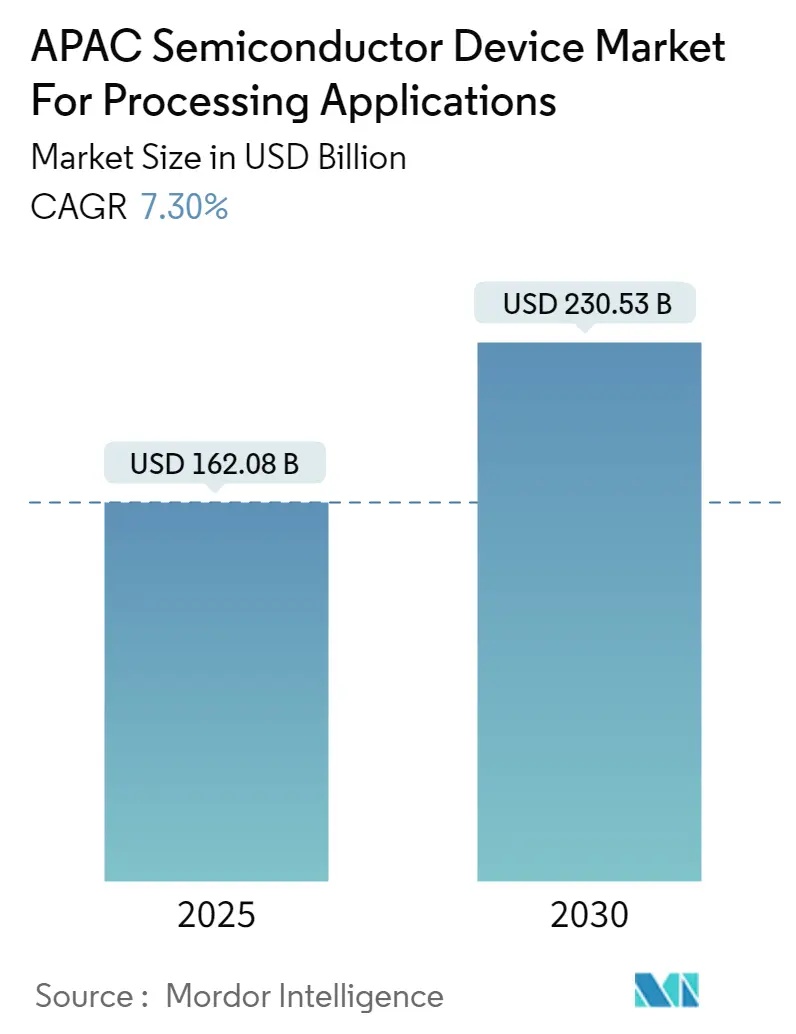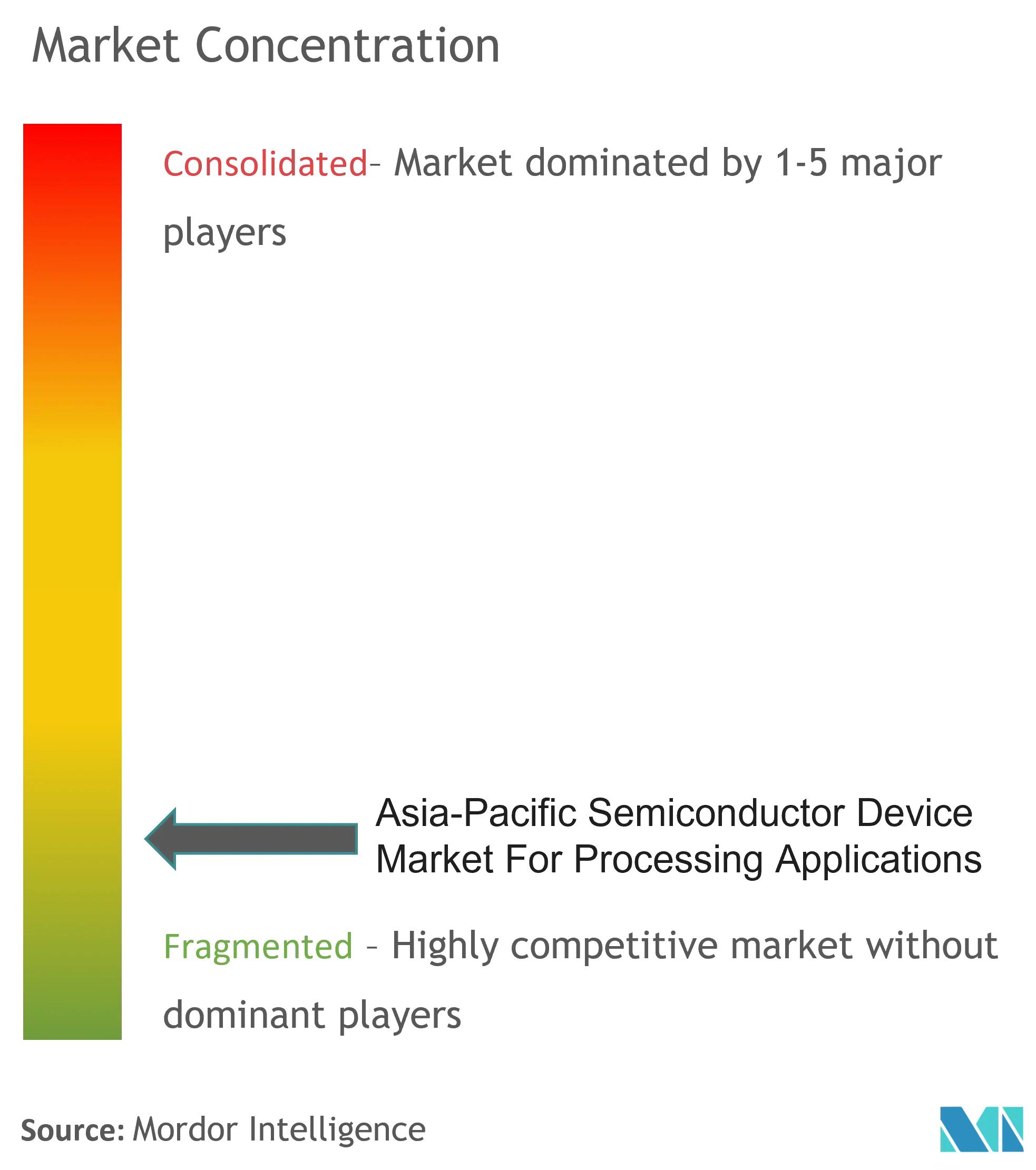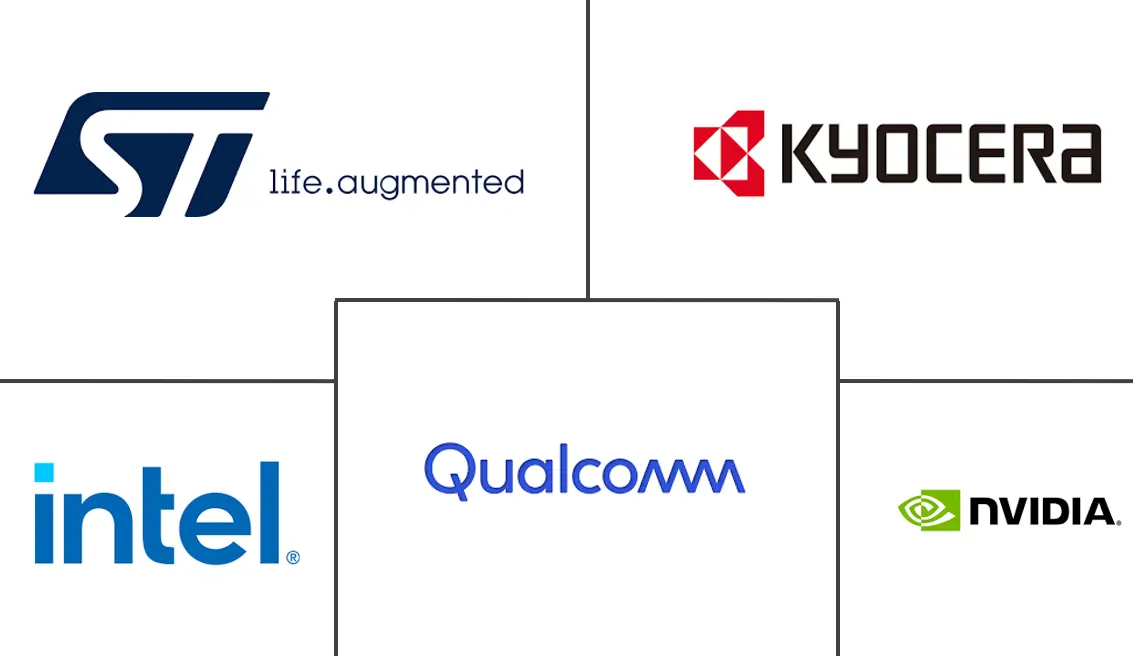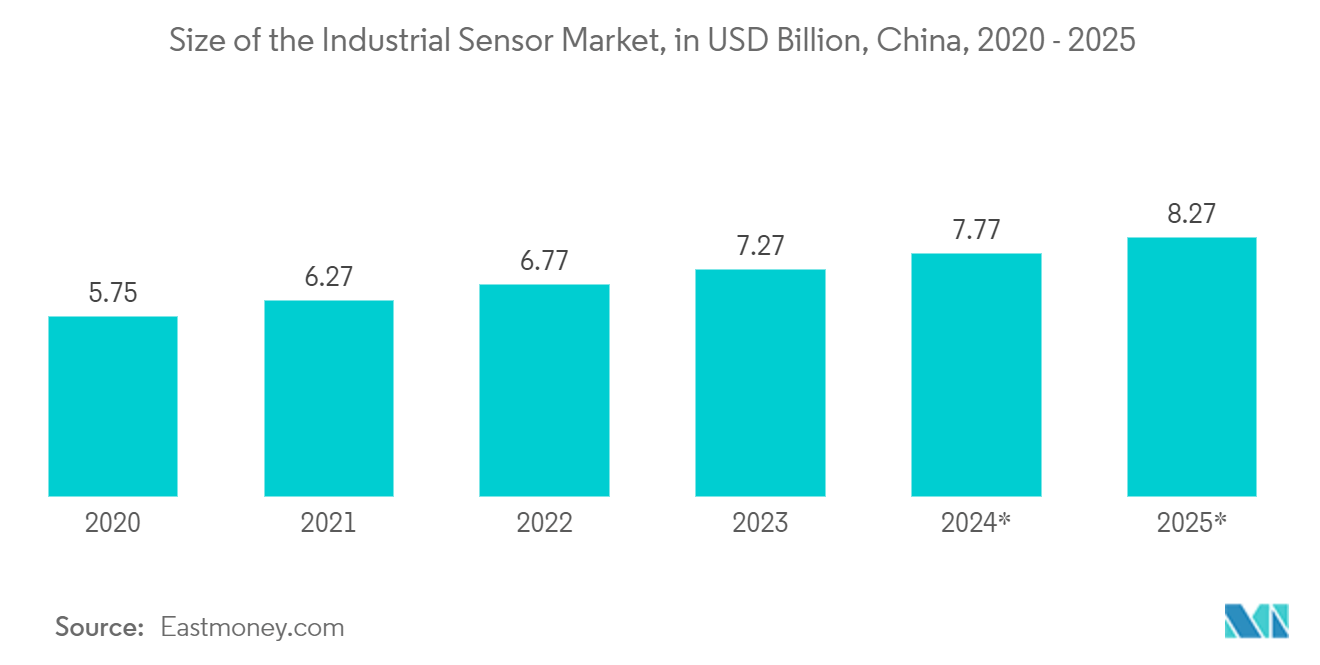
| Study Period | 2019 - 2030 |
| Base Year For Estimation | 2024 |
| Forecast Data Period | 2025 - 2030 |
| Market Size (2025) | USD 162.08 Billion |
| Market Size (2030) | USD 230.53 Billion |
| CAGR (2025 - 2030) | 7.30 % |
| Market Concentration | Low |
Major Players*Disclaimer: Major Players sorted in no particular order |
APAC Semiconductor Device Market Analysis
The APAC Semiconductor Device Market For Processing Applications Industry is expected to grow from USD 162.08 billion in 2025 to USD 230.53 billion by 2030, at a CAGR of 7.3% during the forecast period (2025-2030).
Regional governments launched initiatives to develop the manufacturing and processing industry and recover the growth of semiconductors and manufacturing sectors nationwide. For example, the Japanese government is taking stringent measures to revive its industries, such as manufacturing processes.
- The automation and electrification of manufacturing processes have driven increased demand for semiconductor wafers. Semiconductor ICs with varied functionalities are used in various products, such as infotainment systems, navigation control, HMI, machine vision system, and collision detection systems.
- Moreover, there is enhanced activity from the semiconductor fabrication facilities in Asia-Pacific countries such as China, Singapore, and Korea. Numerous multinational manufacturers of memory direct a large amount of investment into the Chinese semiconductor fabrication market. The country's government initiatives, such as Made in China 2025, significantly support these initiatives. Such initiatives are expected to draw more investments into the country, thus driving the market over the forecast period.
- Moreover, Japan aims to attract overseas companies through financial incentives to secure its chip supplies and address the global shortage. Japan imports significant semiconductors from overseas and wants to build a home supply chain for this technology. During the second pandemic wave, Japan signed off on a JPY 37 billion (USD 0.23 billion) semiconductor research project to develop chip technology in the country with TSMC. About 20 Japanese companies, including Hitachi High-Tech Corp., will work with TSMC on the project, with the Japanese government paying just over half of the cost.
- TSMC formed strategies of opening its first chip plant in Japan as the country pushes to attract more foreign investment into its manufacturing sector. TSMC is considering plans to open a plant in the Kumamoto Prefecture in western Japan, which would help meet the growing demand for image sensors, microcontrollers, and other chips.
- In March 2023, South Korea's parliament approved a bill to boost the country's powerhouse semiconductor industry by giving firms tax breaks to spur investments. The 'K-Chips Act' legislation would increase the tax credit to 15% from the current 8% for major companies investing in manufacturing facilities. At the same time, smaller and medium-sized firms would see the tax break go to 25%, up from 16%. The measure is expected to boost domestic investment for South Korean tech companies such as Samsung Electronics Co. and SK Hynix Inc.
- Further, semiconductors are already Korea's largest export. However, most of that is memory products, NAND Flash, and DRAM memory. The new plan aims to boost the advanced logic chip foundry capacity. Samsung already operates a foundry service with technological capabilities on par with world leader TSMC, but it needs TSMC's volume. SK Hynix has some foundries, but those facilities are far less advanced.
APAC Semiconductor Device Market Trends
Sensors is Expected to Drive the Market
- Sensors are a crucial part of factory automation and Industry 4.0. Motion, environmental, and vibration sensors monitor equipment health, ranging from linear or angular positioning, tilt sensing, leveling, and shock to fall detection.
- Dedicated industrial motion sensors based on micromachined sensing (MEMS) elements are available for manufacturing process applications. These have a wide mechanical frequency sensing bandwidth, high reliability, and accurate operation up to 105°C.
- A high-end sensor system is often powered by a 24V DC source, which is very different from a sensor in a consumer system powered by a 3V or 5V source. As a result, high-end sensor systems require additional power management to drive the sensors effectively. These use digital outputs, such as IO-Link direct to a microcontroller or the wireless transceiver.
- Energy consumption is crucial for industrial processing sensor networks, as thousands of sensor nodes and their wireless transceivers consume significant power. Multiple wireless routing protocols consume less energy, mainly through lower-duty cycles. Higher power is sometimes needed in heavy-duty applications to overcome interference and ensure reliable data acquisition and network reliability.
- In January 2022, Superior Sensor Technology announced the addition of two new pressure sensor families as an extension to its ND series. These new devices enable manufacturers to develop more stable and accurate products cost-effectively for several processing equipment applications operating at low to mid-pressure ranges.
China is Expected to Hold Significant Market Share
- Several initiatives have been taken in recent years to boost the industry's growth. For instance, the Chinese government announced plans to expand the domestic market for electronic components to CNY 2.1 trillion (USD 327 billion) by 2023. The plan covers components, materials, manufacturing equipment used in connected factories, process automation robotics, etc. Specifically, the Chinese government is looking to increase the output of semiconductors, sensors, magnets, fiber-optic equipment, and software, among others. Such initiatives create a positive growth outlook for the studied market.
- In June 2022, Hong Kong-based HG Semiconductor Ltd entered into a framework agreement with China Titans Energy Technology Group Co Ltd to commence three-year strategic cooperation on GaN-based fast-charging pile (station) technology promotion and product sales in mainland China and Hong Kong. HG Semiconductor designs and manufactures LED beads, gallium nitride (GaN) chips, and GaN components, focusing mainly on China.
- Additionally, in February 2022, AXT, Inc. reported expanding operations at its Beijing facility and investing in raw material extraction facilities, strengthening its position as a significant worldwide provider of semiconductor substrates.
- Several regional companies have received robust funding to advance their design and development of semiconductors device for processing applications. According to a report by SEMI, Chinese chipmakers were projected to commence operations on 18 projects in 2024, buoyed by government funding and incentives, aiming to bolster their global chip production share.

APAC Semiconductor Device Industry Overview
The Asia Pacific Semiconductor Device Market is fragmented and is expected to grow in competition during the forecast period. The vendors are focusing on developing customized solution portfolios to fulfill local requirements. Some of the major players operating in the market include Intel Corporation, Nvidia Corporation, Kyocera Corporation, Qualcomm Incorporated, STMicroelectronics NV, Micron Technology Inc., Xilinx Inc., NXP Semiconductors NV, Toshiba Corporation, Texas Instruments Inc., Taiwan Semiconductor Manufacturing Company (TSMC) Limited, SK Hynix Inc., Samsung Electronics Co. Ltd., Fujitsu Semiconductor Ltd., etc.
- August 2022: Toshiba Electronic Devices and Storage Corporation launched the TWxxNxxxC series, a third-generation silicon carbide (SiC) MOSFETs with low on-resistance and significantly reduced switching loss. The products reduce on-resistance per unit area (RDS(ON)A) by approximately 43%, allowing for an 80% reduction in the drain-source on-resistance gate-drain charge (RDS(ON) Qgd). This critical index represents the relationship between conduction loss and switching loss.
- July 2022: Micron Technology, Inc. announced that it had begun volume production of the world's first 232-layer NAND, built with industry-leading innovations to drive unprecedented performance for storage solutions. Micron's 232-layer NAND is a watershed moment for storage innovation as the first proof of the capability to scale 3D NAND to more than 200 layers in production.
APAC Semiconductor Device Market Leaders
-
Intel Corporation
-
Nvidia Corporation
-
Kyocera Corporation
-
Qualcomm Incorporated
-
STMicroelectronics NV
- *Disclaimer: Major Players sorted in no particular order

APAC Semiconductor Device Market News
- April 2024 - Silvaco and GaN Valley have joined forces in semiconductor research. Silvaco brings its technology computer-aided design (TCAD) and EDA software to the table, complemented by GaN Valley's gallium nitride production prowess. Together, they aim to push the boundaries of semiconductor technology, ensuring both compatibility and advancements.
- April 2024 - Sony Semiconductor Solutions Corporation, a Sony subsidiary, has initiated operations on multiple production lines at its new fab, located within the premises of Sony Device Technology (Thailand) Co., Ltd. (“SDT”). SDT primarily handles semiconductor assembly processes. This move, part of an expansion strategy, is designed to bolster production capacity and streamline efficiency. The expansion focuses to increase production capacity and improve the efficiency of the production process, enabling the organization to meet the increasing demand for high-performance semiconductor devices.
APAC Semiconductor Device Industry Segmentation
The study analyzes the market of semiconductor devices for processing applications in terms of the revenue accrued. For the scope of the study, the report includes devices such as Discrete Semiconductors, Sensors, and Integrated Circuits for the market sizing calculation, and all the other devices, such as passive components, are excluded from the study. The study also covers the activities of major players in the market along with their current strategies, recent developments, and product offerings.
The Asia-Pacific semiconductor device market for processing applications by device type (discrete semiconductors, optoelectronics, sensors, and integrated circuits (analog, logic, memory, and micro (microprocessors, microcontrollers, digital signal processors))) and by country (China, India, Japan, South Korea and Rest of the Asia Pacific). The report offers market forecasts and size in value (USD) for all the above segments.
| By Device Type | Discrete Semiconductors | |||
| Optoelectronics | ||||
| Sensors | ||||
| Integrated Circuits | Analog | |||
| Logic | ||||
| Memory | ||||
| Micro | Microprocessors (MPU) | |||
| Microcontrollers (MCU) | ||||
| Digital Signal Processors | ||||
| By Country | China | |||
| India | ||||
| Japan | ||||
| South Korea | ||||
APAC Semiconductor Device Market For Processing Applications Market Research Faqs
How big is the APAC Semiconductor Device Market For Processing Applications Industry?
The APAC Semiconductor Device Market For Processing Applications Industry size is expected to reach USD 162.08 billion in 2025 and grow at a CAGR of 7.30% to reach USD 230.53 billion by 2030.
What is the current APAC Semiconductor Device Market For Processing Applications Industry size?
In 2025, the APAC Semiconductor Device Market For Processing Applications Industry size is expected to reach USD 162.08 billion.
Who are the key players in APAC Semiconductor Device Market For Processing Applications Industry?
Intel Corporation, Nvidia Corporation, Kyocera Corporation, Qualcomm Incorporated and STMicroelectronics NV are the major companies operating in the APAC Semiconductor Device Market For Processing Applications Industry.
What years does this APAC Semiconductor Device Market For Processing Applications Industry cover, and what was the market size in 2024?
In 2024, the APAC Semiconductor Device Market For Processing Applications Industry size was estimated at USD 150.25 billion. The report covers the APAC Semiconductor Device Market For Processing Applications Industry historical market size for years: 2019, 2020, 2021, 2022, 2023 and 2024. The report also forecasts the APAC Semiconductor Device Market For Processing Applications Industry size for years: 2025, 2026, 2027, 2028, 2029 and 2030.
Our Best Selling Reports
APAC Semiconductor Device Market For Processing Applications Industry Report
Statistics for the 2025 APAC Semiconductor Device For Processing Applications market share, size and revenue growth rate, created by Mordor Intelligence™ Industry Reports. APAC Semiconductor Device For Processing Applications analysis includes a market forecast outlook for 2025 to 2030 and historical overview. Get a sample of this industry analysis as a free report PDF download.






